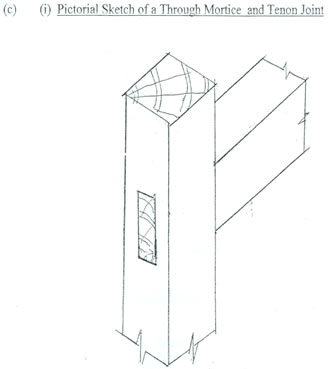Question 8
- (i) Define the term timber conversion;
- (ii) State two reasons for converting timber.
- State two reasons why a carpenter would prefer to use green timber to seasoned timber for formwork construction.
- (i) make a pictorial sketch of a through mortise and tenon joint;
- (ii) state one specific application of a through mortise and tenon joint in joinery.
Observation
Most candidates were able to:
- define the term timber conversion;
- state two reasons for converting timber;
- state two reasons why a carpenter would prefer to use green timber to seasoned timber for formwork construction.
However, some candidates were unable to:
- Make a correct sketching of a through mortise and tenon joint in pictorial view.
- State one specific application of a through mortise and tenon joint in joinery.
The expected response to question 8 is as given below:
8. a)
(i) Timber conversion – is the cutting of logs into commercial sizes.
(ii) Two reasons of converting a timber:
- to make timber available to suit various wood users.
- for easy transportation of timber;
- to get structural sound of pieces of timber;
- To get physically attractive pieces of timber;
- To remove some timber defects;
- For quick drying of timber.
b) Two reasons for using green timber for formwork:
- Easier penetration of nails;
- It reduces absorption of water from concrete.

(ii) One specific application of through mortise and tenon joint.
- between jamb and the head of door and window frames;
- between stiles and rails of paneled doors;
- between muntin and rail of paneled doors/windows;
- in construction of kitchen cabinet.
